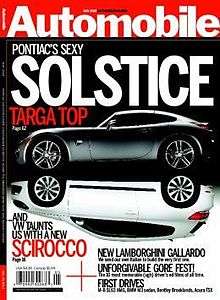Bravia (automobile)
Bravia was a Portuguese vehicle manufacturer. It started by reconditioning military vehicles and by 1964 it had become a manufacturer in its own right. Its best known product is the wheeled APC Bravia Chaimite.
Vehicle Models
See also
References
Denis Miller, The Illustrated Encyclopedia of Trucks and Buses, New Burlington Books, London (1982)
Bravia
Bravia can refer to:

Bravia (brand)
BRAVIA is a brand of Sony Visual Products Inc., a wholly owned subsidiary of Sony Corporation, and used for its television products. Its backronym is "Best Resolution Audio Visual Integrated Architecture". All Sony high-definition flat-panel LCD televisions in North America have carried the logo for BRAVIA since 2005. BRAVIA replaces the "LCD WEGA" which Sony used for their LCD TVs until Summer 2005 (early promotional photos exist of the first BRAVIA TVs still bearing the WEGA moniker). Bravia televisions and their components are manufactured in Sony's plants in Japan, Mexico, and Slovakia for their respective regions and are also assembled from imported parts in Brazil, Spain, China, Malaysia and Ecuador. Principal design work for BRAVIA products is performed at Sony's research facilities in Japan, at the research and development department at the Sony de Mexico facility in Baja California, Mexico and at the Sony Europe facility in Nitra, Slovakia.
The brand is also used on mobile phones in North American, Japanese and European markets.
Bryansk Air Enterprise
Bravia (Bryansk Air Enterprise) was an airline based in Bryansk, Russia. It operates scheduled and charter passenger and cargo services in central Russia. It was formerly known as Aeroflot Bryansk Division.
Code data
Fleet
The Bravia fleet consists of the following aircraft (at January 2005):

Car
A car is a wheeled, self-powered motor vehicle used for transportation and a product of the automotive industry. Most definitions of the term specify that cars are designed to run primarily on roads, to have seating for one to eight people, to typically have four wheels with tyres, and to be constructed principally for the transport of people rather than goods. The year 1886 is regarded as the birth year of the modern car. In that year, German inventor Karl Benz built the Benz Patent-Motorwagen. Cars did not become widely available until the early 20th century. One of the first cars that was accessible to the masses was the 1908 Model T, an American car manufactured by the Ford Motor Company. Cars were rapidly adopted in the United States of America, where they replaced animal-drawn carriages and carts, but took much longer to be accepted in Western Europe and other parts of the world.
Cars are equipped with controls used for driving, parking, passenger comfort and safety, and controlling a variety of lights. Over the decades, additional features and controls have been added to vehicles, making them progressively more complex. Examples include rear reversing cameras, air conditioning, navigation systems, and in car entertainment. Most cars in use in the 2010s are propelled by an internal combustion engine, fueled by deflagration of gasoline (also known as petrol) or diesel. Both fuels cause air pollution and are also blamed for contributing to climate change and global warming. Vehicles using alternative fuels such as ethanol flexible-fuel vehicles and natural gas vehicles are also gaining popularity in some countries. Electric cars, which were invented early in the history of the car, began to become commercially available in 2008.

Automobile (magazine)
Automobile is a United States-based automobile magazine published by TEN: The Enthusiast Network. A group of former employees of Car and Driver led by David E. Davis founded Automobile in 1986 with support from Rupert Murdoch's News Corporation– using the credo No Boring Cars.Automobile distinguishes itself as more of a lifestyle magazine than the other automotive publications, an editorial theme that Davis greatly expanded upon from his tenure as the editor of Car and Driver.
Unlike most other automobile magazines, Automobile does not often do instrumented tests of cars or provide much technical data. Instead, the reviews of vehicles are subjective experiential reports with the cars in their naturally intended, real world environment. Additionally, Automobile reserves a good portion of each issue covering vehicles no longer in production, but still relevant to collectors or automotive history as a whole. For example, the magazine includes features such as "Collectable Classic," an in-depth review of a particular older car, and reports from recent classic and antique car auctions. Automobile also has a regular column by former General Motors designer Robert Cumberford, who analyzes styling elements of current production models and show cars, often linking their design to those of older cars.
Automobile (disambiguation)
An automobile or car is a kind of wheeled motor vehicle. Automobile may also refer to:
Podcasts:

